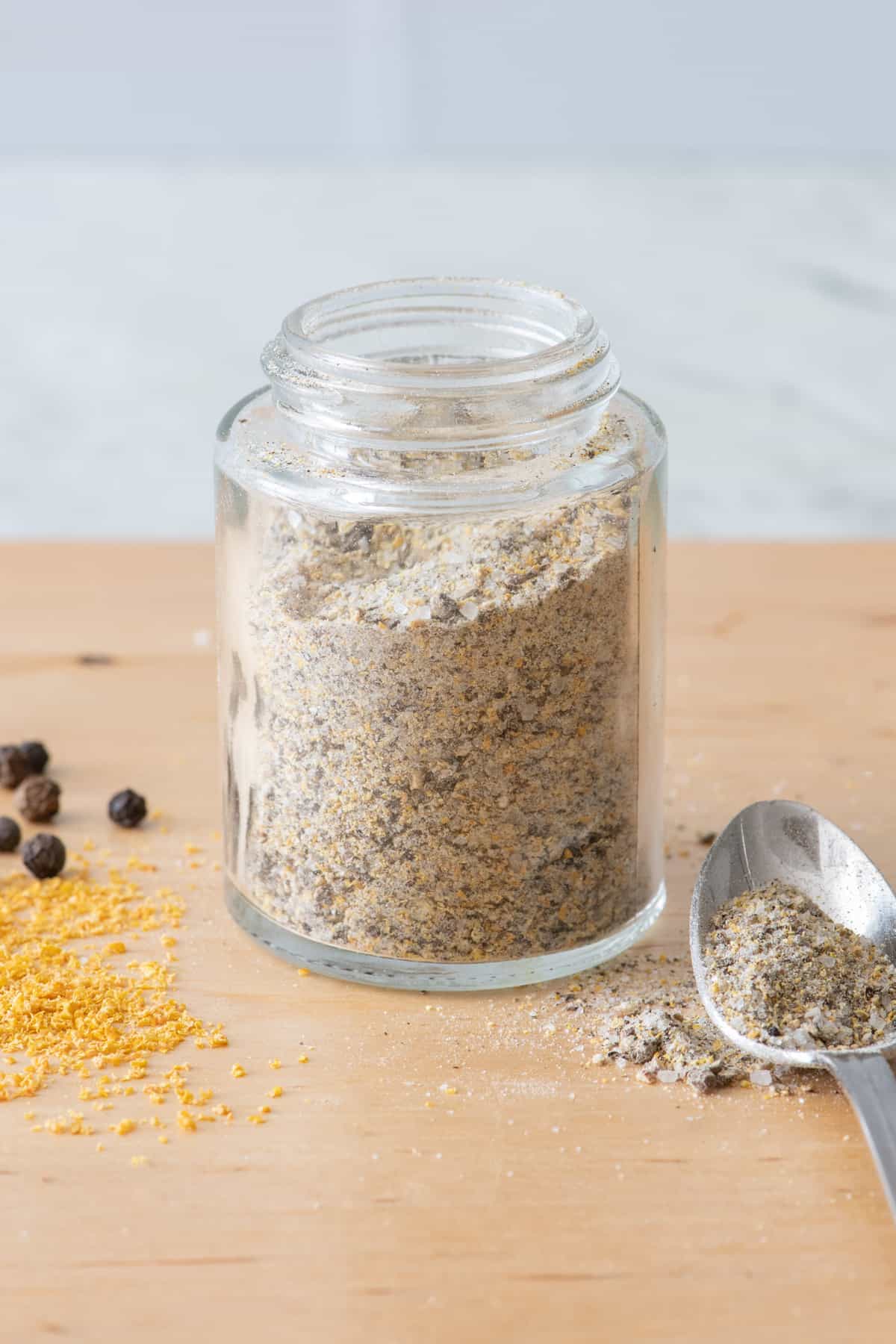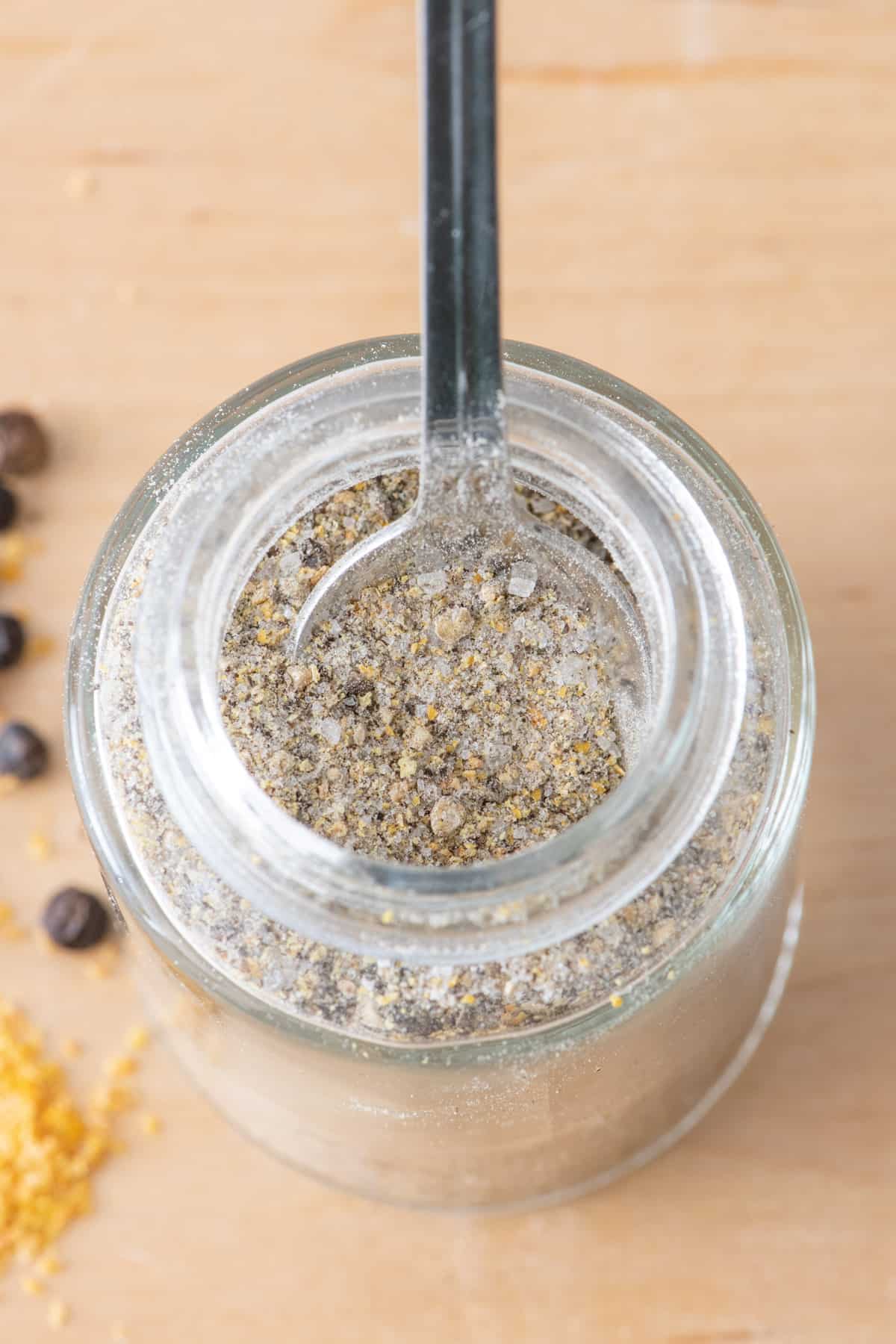How to Make Lemon Pepper Seasoning
Published Feb 17, 2023
Learn how to make lemon pepper seasoning at home with fresh lemon zest. Use it as a dry rub or sprinkle it on seafood, poultry & veggies!
This post may contain affiliate links. Please read our disclosure policy.
Learn how to make Lemon Pepper seasoning from scratch with just 3 ingredients! This homemade lemon pepper brings a bright pop of citrus and a piney black pepper flavor to your seafood, poultry, and vegetable dishes. You can use it as a dry rub or just sprinkle it on top for some added oomph!

Jump to Section
- lemon pepper seasoning uses
- Ingredients to make lemon pepper seasoning
- HOW TO MAKE lemon pepper seasoning
- TIPS FOR the best lemon pepper seasoning
- recipes to make with lemon pepper
- HOW TO STORE homemade lemon pepper seasoning
- FREQUENTLY ASKED QUESTIONS
- OTHER SPICE MIXES TO TRY:
- How to Make Lemon Pepper Seasoning Recipe
Some seasonings are worth buying, but when it comes to making seasoning blends, you just need the main spices to mix it up yourself. In the case of this lemon pepper seasoning, all you’ll need is a spice or coffee grinder to grind the dehydrated lemon zest and whole peppercorns and salt into tiny granules.
Once you’ve learned how simple it is to make your own seasonings from scratch, there’s no turning back. No preservatives, no anti-caking and other additives, just fresh ingredients ready to use on all your favorite recipes. It’s the best lemon pepper seasoning you’ll ever use!
lemon pepper seasoning uses
- Season chicken and fish. Lemon pepper is most commonly used to season chicken and seafood like fish, shrimp, and scallops.
- Season vegetables. To add a fresh citrusy flavor to your veggies, sprinkle a good coating of this peppery, zesty spice. It’s a balanced accompaniment to most vegetables.
- Marinades. Add lemon pepper to your marinades with lemon juice and oil, plus whatever other seasonings you like. Check out my chicken marinade recipes to find one you like.
- Pasta seasoning. A light and buttery sauce would taste amazing with some lemon pepper spice for a subtle citrus taste.
Ingredients to make lemon pepper seasoning
- Lemon zest: You need about 4 lemons worth of zest using a micro plane zester. They’ll then dehydrate in a low-temperature oven for about an hour.
- Peppercorns: Whole peppercorns have a much better taste, and you’re already using the grinder for the lemon zest, so you might as well use a quality ingredient.
- Salt: Use a coarse salt, so it doesn’t turn into dust while grinding.

HOW TO MAKE lemon pepper seasoning
- Place the lemon zest in a single layer on a parchment-lined baking sheet.
- Dehydrate in the oven until completely dry. Allow the zest to cool completely.
- Transfer the lemon zest, along with the peppercorns and salt, into a spice grinder or a small high-powered blender.
- Pulse a few times until the mixture is combined but still has some coarse texture. Store in an airtight container.

TIPS FOR the best lemon pepper seasoning
- Grind to your desired coarseness. You can leave it somewhat coarse, which is great for using as a lemon pepper dry rub, or a little more fine for seasoning.
- Allow the zest to cool. Before grinding the ingredients, let the zest cool completely before grinding to remove any residual heat and prevent the salt from clumping.
- Let the zest dehydrate completely. If by the end of the oven timer, you find the zest is still moist, continue to bake until it is dried and crunchy. You don’t want any moisture added to the seasoning blend as it can cause molding.
- Store in spice jars. Find your favorite spice jar to start filling your cabinet with! I love using glass jars with matching lids to keep everything organized.
- Make it more unique. Lemon zest, peppercorns, and salt create such a delicious blend of spices, but you can take it up a notch and create your own blend. Try mixing in garlic and/or onion powder.
recipes to make with lemon pepper
Use your DIY lemon pepper seasoning with so many different recipes. Substitute the added salt and pepper with equal amounts of this spice blend to add a fresh, lemony, peppery pop of flavor.
- Lemon Pasta
- Air Fryer Green Beans
- Air Fryer Chicken Wings
- Air Fryer Salmon
- Garlic Shrimp Spaghetti
- Grilled Zucchini
- Lemon Garlic Tuna Pasta
- Roasted Chicken
- Roasted Vegetable Quinoa Bowl
HOW TO STORE homemade lemon pepper seasoning
Store spices in a tightly lidded jar in a cool place away from heat and direct light.
HOW LONG WILL lemon pepper seasoning LAST?
Spices lose their potency after about 6 months, so it’s best to use it within that time. But generally, seasonings have a shelf life of up to 2 years. A good way to test for freshness is to check if it still has the same vibrant colors and whether it has a scent or not. If you can’t smell anything, it’s best to toss it and start fresh.
CAN I FREEZE DIY lemon pepper spice blend?
Yes, just store the lemon pepper seasoning in an airtight container and freeze for up to 2 years. It will lengthen its freshness for quite literally years to come!
FREQUENTLY ASKED QUESTIONS
If the lemon zest is not completely dried out and or moisture finds its way into the jar, yes it can mold and spoil. But as long as you ensure that it’s stored properly and the lid remains closed when not in use to prevent moisture build-up and clumping, it will not spoil.
Yes! Lemon pepper seasoning blend is made by drying lemon peels and grinding them into small granules or powder.
Spice should always be stored away from heat in a cool dry place, but if you find yourself with clumpy spices, try adding a few dry beans or rice to the bottle. It’ll absorb any extra moisture keeping your spices loose and dry.

This quick guide shows you exactly how to make lemon pepper seasoning with just 3 ingredients and a little time for preparing the lemon zest, along with my tips for how best to store your DIY spices for freshness. It’s time to stop buying seasoning blends and start making them yourself! You’ll love the results and feel proud to add your freshly made spices to your favorite dishes.
OTHER SPICE MIXES TO TRY:
If you found this tutorial for How to Lemon Pepper helpful or if you try any recipe on Feel Good Foodie, then don’t forget to rate the recipe and leave a comment below! It helps others who are thinking of trying out this tutorial and we would love to hear about your experience. And if you snapped some shots, share it on Instagram so we can repost on Stories!

How to Make Lemon Pepper Seasoning
Ingredients
- 2-3 tablespoons lemon zest from about 5 large lemons
- 2 tablespoons whole black peppercorns
- 2 teaspoons coarse salt
Instructions
- Preheat the toaster oven or oven to 170˚F. Line a small baking sheet with parchment paper.
- Place the lemon zest in a single layer on the prepared baking sheet and place in the oven until the lemon zest is dried completely, about 60 minutes. Allow the lemon zest to cool completely.
- Transfer the lemon zest along with the peppercorns and salt into a spice grinder or a small high-powered blender and pulse a few times until the mixture is combined but still has some coarse texture. (note I over processed mine and it was too fine)
- Store in an airtight container in a spice drawer for up to six months.
Nutrition
Nutrition information provided is an estimate. It will vary based on cooking method and specific ingredients used.






Comments
Shall try it
Let me know what you think after you make it, Tasneem!